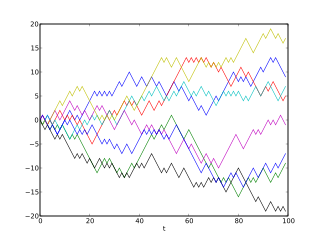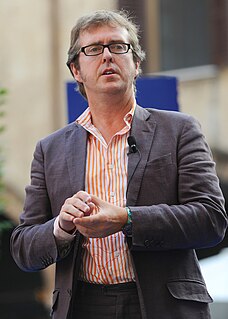
Financial engineering is a multidisciplinary field involving financial theory, methods of engineering, tools of mathematics and the practice of programming. It has also been defined as the application of technical methods, especially from mathematical finance and computational finance, in the practice of finance.
John C. Hull is a Professor of Derivatives and Risk Management at the Rotman School of Management at the University of Toronto.
Financial modeling is the task of building an abstract representation of a real world financial situation. This is a mathematical model designed to represent the performance of a financial asset or portfolio of a business, project, or any other investment.

Computational finance is a branch of applied computer science that deals with problems of practical interest in finance. Some slightly different definitions are the study of data and algorithms currently used in finance and the mathematics of computer programs that realize financial models or systems.
In mathematical finance, the Black–Derman–Toy model (BDT) is a popular short-rate model used in the pricing of bond options, swaptions and other interest rate derivatives; see Lattice model (finance) § Interest rate derivatives. It is a one-factor model; that is, a single stochastic factor—the short rate—determines the future evolution of all interest rates. It was the first model to combine the mean-reverting behaviour of the short rate with the log-normal distribution, and is still widely used.

Emanuel Derman is a South African-born academic, businessman and writer. He is best known as a quantitative analyst, and author of the book My Life as a Quant: Reflections on Physics and Finance.
The following outline is provided as an overview of and topical guide to finance:
A master's degree in quantitative finance concerns the application of mathematical methods to the solution of problems in financial economics. There are several like-titled degrees which may further focus on financial engineering, computational finance, mathematical finance, and/or financial risk management.
Mark Edward Rubinstein was a leading financial economist and financial engineer. He was Paul Stephens Professor of Applied Investment Analysis at the Haas School of Business of the University of California, Berkeley. He held various other professional offices, directing the American Finance Association, amongst others, and was editor of several first-tier academic journals including both the Journal of Financial Economics and the Journal of Finance. He was the author of numerous papers and four books.
Neil A. Chriss is a mathematician, academic, hedge fund manager, philanthropist and a founding board member of the charity organization "Math for America" which seeks to improve math education in the United States. Chriss also serves on the board of trustees of the Institute for Advanced Study.

Paul Wilmott is an English researcher, consultant and lecturer in quantitative finance. He is best known as the author of various academic and practitioner texts on risk and derivatives, for Wilmott magazine and Wilmott.com, a quantitative finance portal, and for his prescient warnings about the misuse of mathematics in finance.
Damiano Brigo is an applied mathematician and Chair in Mathematical Finance at Imperial College London. He is known for research in filtering theory and mathematical finance.
A master's degree in Financial Economics provides a rigorous understanding of theoretical finance and the economic framework upon which that theory is based. The degree is postgraduate, and usually incorporates a thesis or research component. Programs may be offered jointly by the business school and the economics department.
Salih Nur Neftçi was a leading expert in the fields of financial markets and financial engineering. He served many advisory roles in national and international financial institutions, and was an active researcher in the fields of finance and financial engineering. Neftçi was an avid and highly regarded educator in mathematical finance who was well known for a lucid and accessible approach towards the field.
Quantitative analysis is the use of mathematical and statistical methods in finance and investment management. Those working in the field are quantitative analysts (quants). Quants tend to specialize in specific areas which may include derivative structuring or pricing, risk management, algorithmic trading and investment management. The occupation is similar to those in industrial mathematics in other industries. The process usually consists of searching vast databases for patterns, such as correlations among liquid assets or price-movement patterns. The resulting strategies may involve high-frequency trading.
Mathematical finance, also known as quantitative finance and financial mathematics, is a field of applied mathematics, concerned with mathematical modeling of financial markets. See Quantitative analyst.
Robert F. Almgren is an applied mathematician, academic, and businessman focused on market microstructure and order execution. He is the son of Princeton mathematician Frederick J. Almgren, Jr. With Neil Chriss, he wrote the seminal paper "Optimal execution of portfolio transactions," which Institutional Investor said "helped lay the groundwork for arrival-price algorithms being developed on Wall Street." In 2008 with Christian Hauff, he cofounded Quantitative Brokers, a financial technology company providing agency algorithmic execution in futures and interest rate markets. He is currently Chief Scientist at QB and a visiting professor in Operations Research and Financial Engineering at Princeton University.
David Clay Heath was an American probabilist, who is most famous for the co-invention of the Heath–Jarrow–Morton framework to model the evolution of the interest rate curve.

Blessing Mudavanhu is a Zimbabwean mathematician, corporate executive, academic, businessman and entrepreneur, who is the founder and president of Dura Capital Limited, a company that he founded in 2006, at the age of 35 years. Effective 1 June 2018, he serves as the Group CEO of CBZ Holdings, a financial services conglomerate (company) in Zimbabwe.




